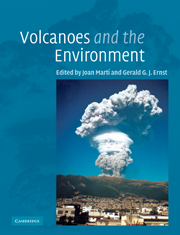Book contents
- Frontmatter
- Contents
- List of contributors
- Preface
- Acknowledgments
- Chapter 1 Understanding the physical behavior of volcanoes
- Chapter 2 Volcano hazards
- Chapter 3 Anticipating volcanic eruptions
- Chapter 4 Volcanoes and the geological cycle
- Chapter 5 Effects of volcanic eruptions on the atmosphere and climate
- Chapter 6 Volcanoes, hydrothermal venting, and the origin of life
- Chapter 7 Volcanism and mass extinctions
- Chapter 8 Effects of modern volcanic eruptions on vegetation
- Chapter 9 Animals and volcanoes: survival and revival
- Chapter 10 Human impacts of volcanoes
- Chapter 11 Volcanoes, geothermal energy, and the environment
- Chapter 12 Volcano-hosted ore deposits
- Chapter 13 Industrial uses of volcanic materials
- Chapter 14 Volcanoes, society, and culture
- Chapter 15 Volcanoes and the economy
- Index
- References
Chapter 8 - Effects of modern volcanic eruptions on vegetation
Published online by Cambridge University Press: 14 November 2009
- Frontmatter
- Contents
- List of contributors
- Preface
- Acknowledgments
- Chapter 1 Understanding the physical behavior of volcanoes
- Chapter 2 Volcano hazards
- Chapter 3 Anticipating volcanic eruptions
- Chapter 4 Volcanoes and the geological cycle
- Chapter 5 Effects of volcanic eruptions on the atmosphere and climate
- Chapter 6 Volcanoes, hydrothermal venting, and the origin of life
- Chapter 7 Volcanism and mass extinctions
- Chapter 8 Effects of modern volcanic eruptions on vegetation
- Chapter 9 Animals and volcanoes: survival and revival
- Chapter 10 Human impacts of volcanoes
- Chapter 11 Volcanoes, geothermal energy, and the environment
- Chapter 12 Volcano-hosted ore deposits
- Chapter 13 Industrial uses of volcanic materials
- Chapter 14 Volcanoes, society, and culture
- Chapter 15 Volcanoes and the economy
- Index
- References
Summary
Introduction
In any one year, approximately 60 volcanoes erupt on the Earth. Even though about 80% of these eruptions occur under the oceans, the terrestrial volcanic events are common enough to have major impacts on nearby vegetation, often over large areas (e.g., Bilderback, 1987). Volcanic activity both destroys or modifies existing vegetation and creates new geological substrates upon which vegetation can re-establish. The types of plants surviving and recovering after volcanic activity largely depend upon the type of activity that takes place, the nutrient content of material ejected or moved by the volcano, the distance from the volcanic activity, and the types of vegetation propagules that survive in place or are transported from adjacent areas. The resulting changes in the vegetation abundance and patterning can have dramatic effects on the social and economic conditions of the humans in the areas surrounding volcanoes.
Impacts of volcanoes on existing flora
Physical impacts
Primary impacts
The primary impacts of volcanic activity on vegetation correlate to the specific type of volcanic activity (Table 8.2). In associating impacts with types of volcanic activity, we refer to the many studies on vegetation survival and reestablishment that have been conducted on volcanoes (Table 8.1). We divide the volcanic activities into six categories: lava formation, pyroclastic flows, debris avalanches, mudflows, tephra and ash depositions, and blowdowns.
- Type
- Chapter
- Information
- Volcanoes and the Environment , pp. 227 - 249Publisher: Cambridge University PressPrint publication year: 2005
References
- 23
- Cited by



